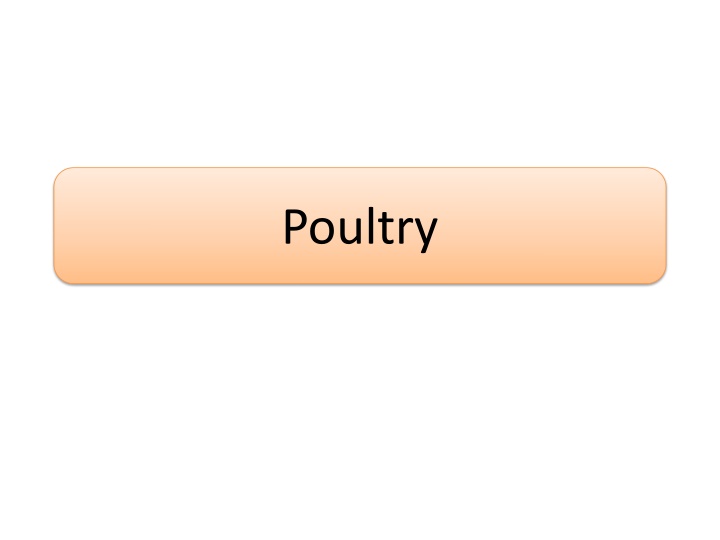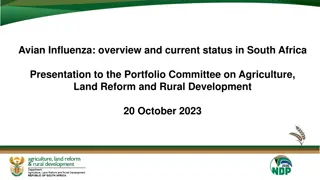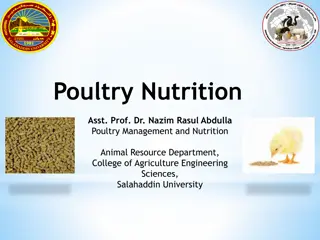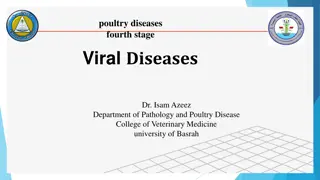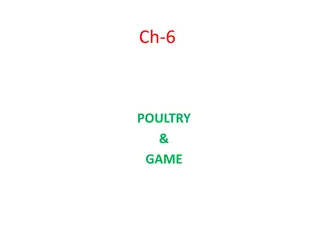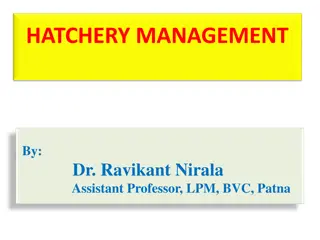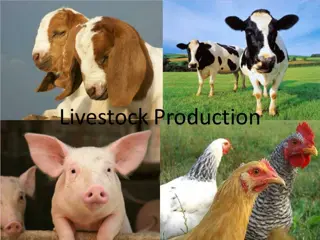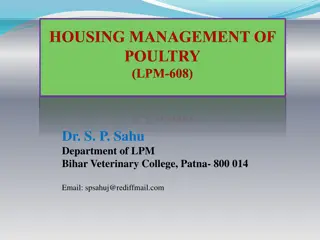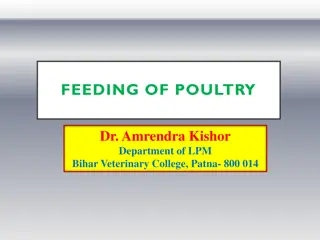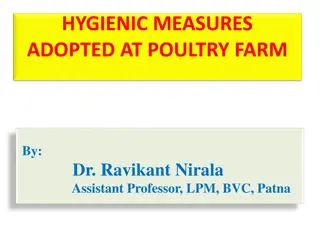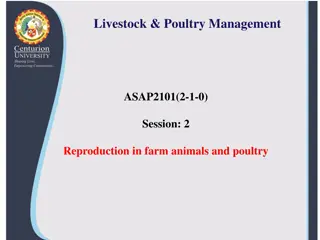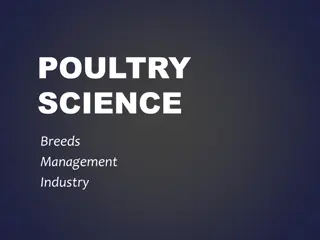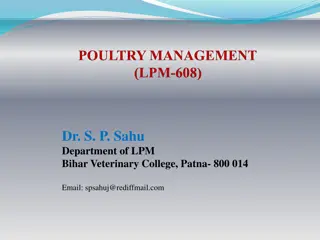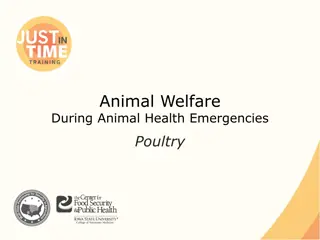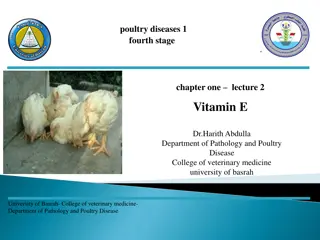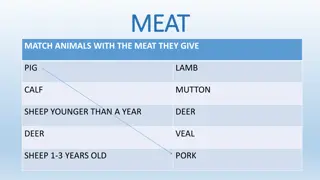All About Poultry: Nutrition, Quality, and Preparation
Explore the world of poultry, from the definition and nutritional value to the specific categories and cuts available. Learn about the quality indicators, storage tips, and hygiene practices for fresh and frozen fowl. Discover the various types of poultry, their weights, ages, and culinary uses. Enhance your menu with menu suggestions and elevate your cooking with the knowledge of preparing different cuts of poultry.
Download Presentation

Please find below an Image/Link to download the presentation.
The content on the website is provided AS IS for your information and personal use only. It may not be sold, licensed, or shared on other websites without obtaining consent from the author.If you encounter any issues during the download, it is possible that the publisher has removed the file from their server.
You are allowed to download the files provided on this website for personal or commercial use, subject to the condition that they are used lawfully. All files are the property of their respective owners.
The content on the website is provided AS IS for your information and personal use only. It may not be sold, licensed, or shared on other websites without obtaining consent from the author.
E N D
Presentation Transcript
Learning Outcomes Definition of Poultry Nutritional Value of Poultry Points of Quality, Storage & hygiene Methods of Preparation & Cuts Categories of Poultry Menu Suggestions
Definition of Poultry Poultry applies to the category of all domesticated fowls (bird) breeds. Chicken, Turkey, Duck, Goose, Quail, Guinea Fowl & Pigeon are all classified as Poultry. Bred and reared for their Meat, Eggs and some for there Feathers. Certain breed are solely bred for egg production only. Approximately 15-20% of a bird is bone.
English French Weight Age 300 -500g Single/ Spring Chicken Poussin 4 6 weeks 1 - 1 kg Young Chicken Le Poulet de Grain 8 12 weeks 1 -2 kg Chicken Le Poulet Reine 4 6 months 1 - 1 kg Yong Fat Chicken La Poulardin 4 6 months 2 -4 kg Fat Chicken La Poularde 5 6 months 2 -4 kg Capon Le Chapon 5 6 months 2 -3 kg Boiling Fowl La Poule 12 months 3 4 kg Young Turkey Le Dindonneau 5 6 months 6 12 kg Turkey Dinde 6 10months 2 3kg Duck Le Cannard 3 4 months 1 - 2 kg Ducking Le Caneton 2 3 months 4 7 kg Goose L Oie 6 10months 2 3 kg Gosling L Oison 4 6 months 300 500g Pigeon Le Pigeon 6 10 weeks 125 150g Quail La Caille 6 8 weeks 1 - 2 kg Guinea Fowl La Pintade 4 6 months
Nutritional & Food Value of Poultry Classified as White Meat so it is high in Protein. Easier to digest, than other meat. Low Fat content, but high percentage of unsaturated fatty acids. Beneficial for body building and repair. A very good source of energy.
Points of Quality, Storage & Hygiene Fresh Fowls; Flesh firm but pliable, with a fine texture. Not too much fat, especially in abdominal cavity. White or yellow skin, according to breed. No cuts, scores, rubbed portions on skin or blood patches. The breast should be straight, broad and well fleshed. Wings compact, small head, with neat comb and wattles. The bones fine, legs short and well fleshed.
Points of Quality, Storage & Hygiene Frozen Fowls; Packaging should be undamaged. There should be no freezer burn (white patches on the skin). Breasts should be plump and breast bones pliable. Flesh should be firm. Skin should be unbroken and white
Points of Quality, Storage & Hygiene Store chilled birds at 1 C to 4 C. Deep frozen at -18 C to -22 C Oven-ready birds are eviscerated and should be stored in a refrigerator. Defrost (thaw) completely before cooking , at the bottom of refrigerator in a tray with a rack and covered. This is to ensure that the whole bird reaches a high temperature when cooking, to kill off Salmonella (Chickens are potential carriers).
Methods of Preparation & Cuts Saut Cuts 1 Wing 2 Breast 3 Thigh (Leg) 4 Drumstick (Leg) 5 Winglet 6 Carcass Trussing; Entry Points When trussing using a needle Cuts for Saut & Fricass e
Methods of Preparation & Cuts; Spatchcock Spatchcock is the preparation of a spring /single chicken for grilling ; Remove the wishbone. Place the bird on its back. Insert a large knife through the neck end, out of the vent. Cut through the backbone and open out . Remove back and rib bones. Lightly flatten with a cutlet bat
Methods of Preparation & Cuts; Suprme A Supr me is half of a boned-out breast of chicken with a trimmed winglet bone attached. 3. If the carcass is removed the breasts are called a Crown 1. Remove the legs 2.Remove the wishbone 5. Cut through the winglet joint to release the breast 4.Cut along the breastbone down to the wing joint 6. The finished Supr me
Methods of Preparation & Cuts; Ballotine A Ballotine is a boned out stuffed leg Remove the thigh bone with a small shape knife. Scrape the flesh off the drumstick downwards. Chop off the drumstick bone leave only 2-3cm at the end where the claw is.
Categories of Poultry; Chicken Chicken is a direct descendant of the jungle fowl of the Indian sub-continent, cross-bred to produce the bird we know today. Chicken applies for all birds irrespective of age or size. Bred for their meat (white) and for their eggs. Can be mass produced on special farms or left to freely roam and feed (Free-Range) which have a much better flavour and texture Corn Fed chickens that are on a special diet of corn which produce a yellowish flesh.
Categories of Poultry; Turkey Domesticated turkey descends from the wild turkey, a native of North America Very feasible and economical to produce due to its yield. White turkey meat (breast) has more nutritional value and is generally considered healthier Weigh from 3.5-20 kg, allow200 g (raw weight) per portion. Remove wishbone before trussing (to make carving easier). Draw the sinews out of the legs. When cooking a large turkey the legs may be removed, boned, rolled, tied and roasted separately from the remainder of the bird. This reduces cooking time and allows even cooking.
Categories of Poultry; Duck Originating from the wild duck it is now domestically bred , top breeds, Aylesbury, Rouen, Nantes, Barbary and Pekins. The meat is mostly on the breast (Magret) meat of the legs is darker. Best slaughtered at 6 months old. Duck liver is a good substitute for goose liver in (Foie Gras)
Categories of Poultry; Goose Geese are at their best while still young, up to 6 months old, 'goslings' or 'green geese'. From 6 months onwards they are then simply called geese. After 1 year the meat becomes very tough and is really only suitable for braising. Geese produce the famous goose liver (Foie Gras) , the fat is also used to cook (confit). Geese produce large edible eggs, weighing 120-170g.
Categories of Poultry; Guinea Fowl Guinea fowl is not strictly poultry, only semi domesticated . A member of the pheasant family and originated in West Africa but has been reared in Europe since the fifteenth century. Tastes like a cross between chicken and pheasant with a slightly gamey flavour, texture more like that of pheasant. Best slaughtered between 8 and 9 weeks, weighting 1-1 kg , has heavier bone structure than a chicken and less meat.
Categories of Poultry; Quail Quail is not strictly poultry but more like domestic game, it has been bred domestically for 4000 years (Japan). Quails are still to be found in the wild as they are a migratory bred. Commercially bred quail are slaughtered at 6 to 8 weeks, weighting 125-150g. Bred for their eggs which is considered to be a delicacy, but are high in cholesterol.
Categories of Poultry; Pigeon Domesticated pigeon was derived from the Rock Pigeon. The Utility Pigeon is specially breed that are reared for meat, in culinary terms called , Squab. Bresse pigeon (France) is considered a superior breed. Slaughtered a month old when they have reached adult size but has not flown. Produces relatively little meat in bird, the meatiest part are the breasts, legs are very tough and have small amounts of meat.
Menu Suggestions Ballotine of Chicken Roast Magret of Duck with orange essence Roast Festive Turkey Honey Glazed Quail with a red wine reduction Pan-Seared Foie Gras A Duo of Guinea Fowl
